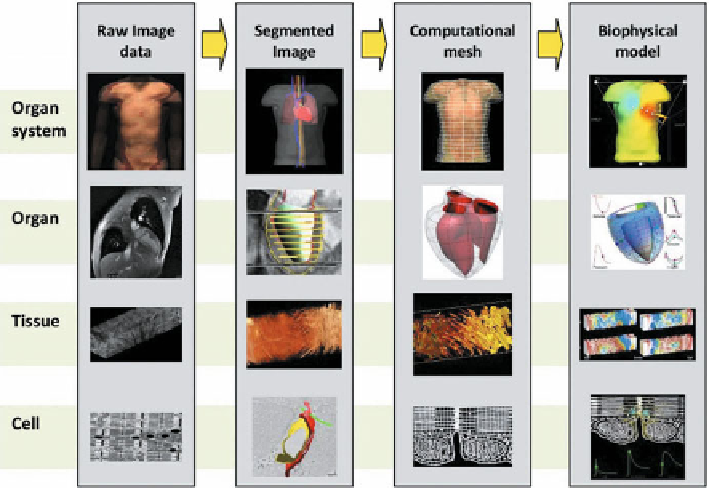Biomedical Engineering Reference
In-Depth Information
Fig. 8.11.
Illustration of the process (left to right) of segmenting image data to create computational
meshes on which the equations representing biophysical processes can be solved for each of the
four spatial scales characteristic of the physiome project - organ system, organ, tissue and cell.
A similar process, not shown, occurs at the protein level, where X-ray diffraction data gives rise
to 3D atomic structure on which molecular modelling allows protein phenotype to be predicted.
In fact a model at any one scale needs to merge different physical processes that operate at each
of these spatial scales. The biophysical processes being modelled in the right hand column are,
from bottom to top, calcium diffusion from ryanodine receptor (RyR) release sites to troponin-C
(TnC) binding sites in the cardiac myocyte, electrical activity in a transmural block of myocardial
tissue, the spread of electrical activation and the subsequent mechanical contraction around the left
ventricle, and the spread of cardiac generated electrical activity over the torso together with the
computed vector cardiogram (Reproduced with permission from [21])
lowed by segmented surfaces of the transverse tubules and surrounding junctional
endings of the sarcoplasmic reticulum. This is used to create the two dimensional
mesh that is then used to examine calcium fluxes released from ryanodine receptors
and taken up first by binding to troponin C (to activate myofilament contraction) and
then the SERCA pumps that recycle calcium back to the release sites. Not shown in
Fig. 8.11 is the multiplicity of biophysical processes that operate at each of these
levels.
Linking spatial scales
The hierarchy of spatial scales for heart modelling is illustrated in Fig. 8.12. Note
that a number of physical processes must be integrated at each scale. For example,
at the organ level, the large deformation mechanics of the ventricular wall is cou-
pled to the computational fluid dynamics of blood flow within the ventricles and in

